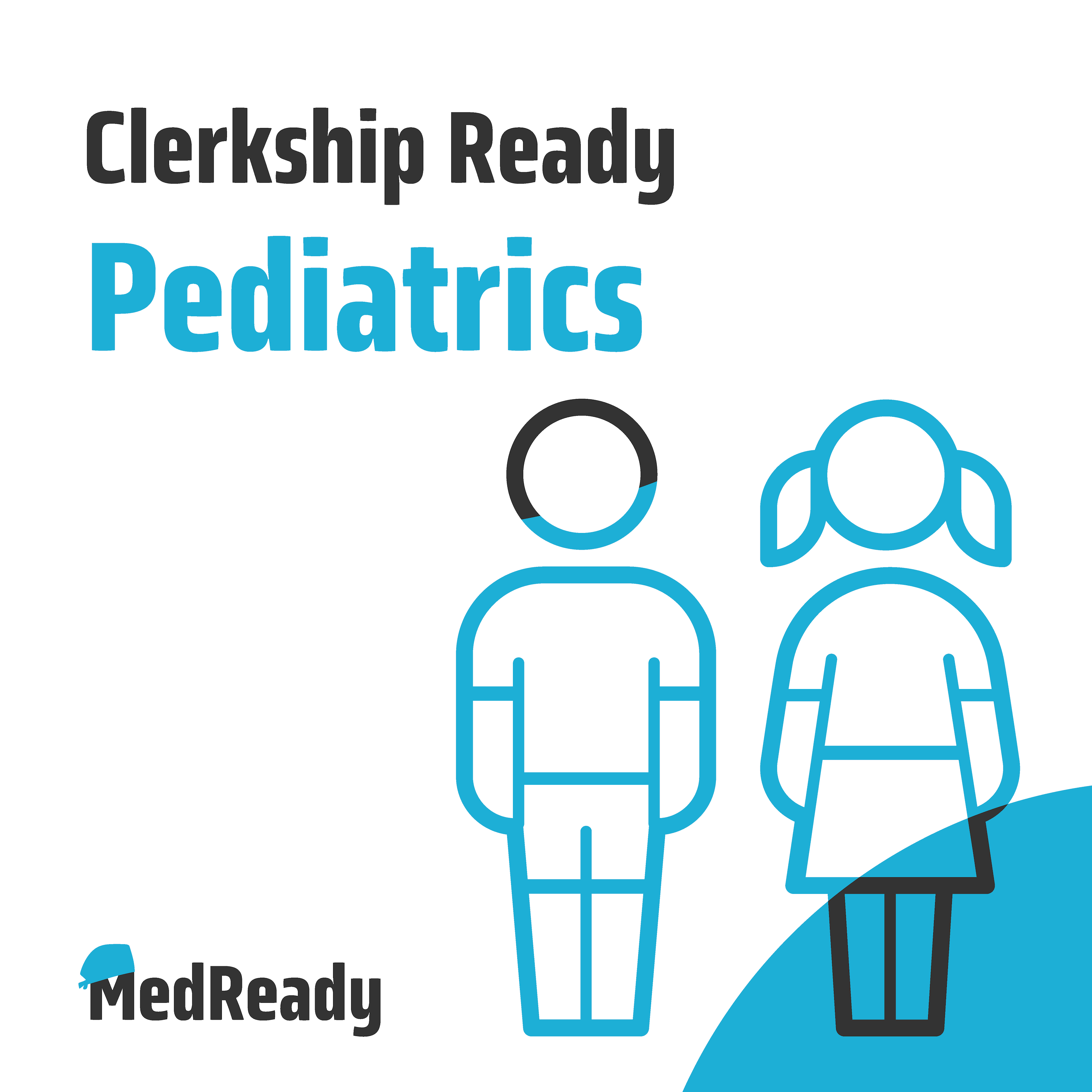Episode Transcript
Hi and welcome to Clerkship ready pediatrics a podcast aimed at helping you excel during your clinical rotation in pediatrics. my name is Jeremy Middleton I’m a pediatric gastroenterologist in Associate Professor a Pediatrics in the culture Director at the University of Virginia.
Today we’ll discuss how to be best prepared when headed to the pediatric G.I. clinic
Pediatric gastroenterology is a sub specialty clinic caring for children of a variety of ages from infancy to adolescence for a host of gastrointestinal, pancreatic, liver and nutrition issues. A sub specialty in pediatric gastroenterology is an additional three year fellowship after the three year pediatric residency.
While you are in Peds GI I clinic, you may see any number of clinical conditions, or you may be able to focus on a single patient population during a specialty G.I. clinic. These specific clinics can include feeding disorders, inflammatory bowel disease, intestinal rehabilitation, eosinophilic gastrointestinal disorders, liver transplant, motility disorders or aerodigestive issues. It will be important for you to know which type of patients you will be seeing during your pediatric G.I. clinic day.
For the purpose of this podcast, we will concentrate our conversation on being in a general pediatric G.I. clinic. Like in all outpatient pediatric clinics, it will be important for you to briefly orient yourself to the clinic space, and ask your attending about any specific expectations and the overall objectives of the clinic experience. Make sure to know whether you are responsible for writing the notes, and How efficient you should be during your patient interactions. Some clinics can move quite fast, and you need to make sure that you are not slowing down the pace of the clinic. You should also understand how to best utilize the electronic medical record to find past notes, or notes from outside facilities so you can have a good understanding of the patient before going into the room.
Let’s now think about children with gastrointestinal disorders. Some of the main chief complaints are chronic abdominal pain, diarrhea, bloody stools, weight loss, nausea/vomiting and difficulty swallowing. Some of the more common gastrointestinal issues that you may encounter are chronic inflammatory conditions such as Crohn’s disease, ulcerative colitis, celiac disease and eosinophilic esophagitis. You may also be exposed to children with an infectious disease like H. pylori leading to gastritis or ulcers, or acute infectious diarrhea including C. difficile colitis. One of the more common problems seen in general G.I. clinic are what are referred to as functional gastrointestinal disorders or disorders of the gut – brain axis. Conditions such as irritable bowel syndrome, functional constipation, cyclic vomiting, rumination syndrome, functional dyspepsia and abdominal migraine all fit into this category.
When approaching a child in the pediatric G.I. clinic, it is important to get a precise understanding of the symptoms. Don’t presume the words patients use are exactly what you think they are. Frequently, patients will use the term vomiting when in fact they are regurgitating. Or they will say pain when they really mean nausea. Speaking of pain, the PQRST mnemonic is helpful – make sure you know what provoked the pain, the quality of the pain, whether the pain radiates, how severe the pain is, the timing of the pain and what the family has used to help treat the pain. Specific questions to ask in Peds GI I clinic would be if the pain wakes the patient at night, how much school or other activities the Patient has missed because of symptoms, whether defecation or passage of gas alleviates pain and specific dietary changes The Family may have already tried. Children with a disorder of the gut-brain axis, like irritable syndrome, are more likely to have missed out on school, or activities because of symptoms. In addition, frequently there are other somatic complaints including sleep disorders, chronic headache, lightheadedness from postural orthostasis tachycardia syndrome, anxiety/depression and chronic fatigue that are also common in these patients. It is important to ask about these symptoms in addition to the gastrointestinal issues. Because there continues to be stigma around anxiety and abdominal symptoms, frequently asking whether stress or being worried exacerbates symptoms is a good way to understand whether psychosocial stressors may be playing a part in the chronic abdominal symptoms.
Obviously in Peds GI I clinic, you’ll have to ask about some pretty disgusting stuff! Don’t be bashful, just come out and ask about pooping! Whether you say bowel movement, defecation, stooling or pooping, make sure the patient and the family know exactly what you’re referring to. Be sure to understand the quality of the stool, size and caliber of the bowel movement. You can always use the Bristol stool scale as a pictorial way to represent types of stool. In children with diarrhea, asking about dietary changes, or exacerbating symptoms is important. One of the most important questions is to ask about nocturnal stools. In children with osmotic diarrhea, they will not be eating at night and so they will Not have nocturnal stooling. Any children with inflammatory Or secretory diarrhea may wake up one or more times at night to have bowel movements. One of the most common problems a pediatric gastroenterologist encounters is constipation. The biggest reason we see constipation is because children will withhold after a painful bowel movement and then this leads to problems. If children associate bowel movements with pain, they will do everything in their power to withhold that stool, and this can lead to bloating, decreased appetite, large painful bowel movements and even vomiting. It's important to ask whether children have stool accidents, which we call encopresis, and whether there are any urinary or neurologic issues that may be going on as well. Although far and away the most common reason for pediatric constipation is withholding, you have to think about Hirschsprung disease which is why asking about Passage of meconium in the first 48 hours of life is such a key question during your history.
Pediatric gastroenterologists also think a lot about the upper G.I. tract. Although gastroesophageal reflux is common in children, there is a rising prevalence of eosinophilic esophagitis. One of the most common reasons for infants to come to the gastroenterologist is reflux. Infant reflux, for the most part, is physiologic. The vast majority of infants will have some amount of reflux or regurgitation by six months of age and it can last as long as 15 to 18 months old. Although reflux can be perceived as quite troublesome, as long as infants are thriving, infants will grow out of this condition. Frequently there are other associated symptoms such as fussiness, back arching or abdominal distention, and it will be important to make sure there are no other issues going on such as cow milk protein allergy or anatomic problems such as antral web or pyloric stenosis. Less common is that the problem stems from a distal intestinal process such as anal stenosis or even Hirschsprung disease. Most of the time, supportive measures such as using antireflux formula, adding oatmeal to bottles, more frequent feeds, early introduction of solids, or even a bowel regimen can be helpful to provide tools The Family can use to get through reflux symptoms. Few infants will need acid blocking medication‘s, because most physiologic reflux is postprandial and not acidic. older children definitely can experience reflux symptoms in the form of heartburn, chest pain or even regurgitation. It is important to try and sort out whether a child has gastroesophageal reflux disease or eosinophilic esophagitis. Understanding If there is a history of atopy including food allergy, seasonal allergic rhinitis, asthma or eczema will be important. Subtle symptoms of EoE is that a child may be a very slow eater, or requires fluids throughout a meal. Although food impaction can be a common symptom in adolescents and adults, that is less frequently seen in school-age children where the primary symptom of EOE can be generalized abdominal pain, frequent throat clearing, Avoidance of certain foods or persistent regurgitation symptoms.
When approaching a child to perform a physical exam in G.I. clinic, you will want to be relatively thorough. Growth parameters are so important in PEDSGI, and you should not only look at the height, weight and BMI percentile, but also the trajectory if you have growth parameters prior to the visit. Reviewing vital signs is also imperative, and getting a good general assessment of the patient. Make sure to evaluate for conjunctival pallor, oral ulcers, and tonsillar hypertrophy when evaluating the head and neck. Feel for lymphadenopathy in the neck, axilla and inguinal regions. Look at the patient's hands for signs of pallor, clubbing from chronic inflammation, and pitting of the nail beds. Abdominal exams in children can be tricky, and distraction can go along way. Think about having the child put their knees up, and if they’re super ticklish you can have them put their hand on their abdomen and you push over top of it to evaluate for pain. A good trick is to listen with your stethoscope but push down while you’re listening to assess for discomfort. Another very important physical exam maneuver is to percuss and palpate for the liver. It is important to start percussion low and work your way up to the rib cage. If you hear and feel a change of residence why are you percuss prior to the rib cage, that is likely due to an enlarged liver. Although check with your attending physician about performing GU and rectal exams, it is a very important part of the physical exam in G.I. clinic. Not only are you assessing the position of the anus to make sure that it is not anterior, but you were looking for signs of skin tags, abscess or fissure as well. Frequently patients with perianal Crohn’s disease Will have skin tags that providers confuse for hemorrhoids. Hemorrhoids are less common in children than adults, and it’s important to realize the difference between a tag and a hemorrhoid. In children with chronic constipation, a digital exam will allow you to evaluate for signs of stricture, but also whether there is a large hard impaction That will require an aggressive clean out plan. Other important examination features would be a thorough dermatologic exam, as well as feeling for any joint swelling since extra intestinal manifestations of celiac disease and Crohn’s disease can present with skin or joint findings.
When presenting in Peds GI I clinic, typically you’ll either have an initial visit or a follow up. For initial visits, you will need to provide a full history, past medical history, family history, social history, physical exam along with your assessment plan. I would recommend providing previous work up in laboratory studies in your history of present illness. During follow up visits, it’s important to know the timing of the last visit, The previous prescribed plan, and any interval change. Make sure to include pertinent physical exam features in your assessment and do your best to come up with an evaluation and treatment plan for the patient.
Good luck in Peds GI I clinic, and hopefully this will help you excel and get the most out of your clinic experience. Thanks for listening to Clerkship Ready Pediatrics. Hope you found today’s podcast helpful. Don’t forget to subscribe below and write the podcast.
Outro:
Thanks for listening to Clerkship Ready - Pediatrics. Hope you found today’s podcast helpful. Don’t forget to subscribe below and rate the podcast!

